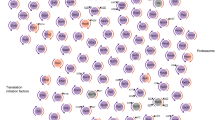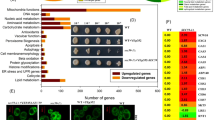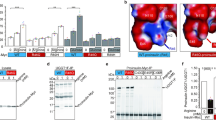Abstract
The formation of disulphide bonds in mammalian secretory and cell-surface proteins occurs in the lumen of the endoplasmic reticulum and is believed to be catalysed by the enzyme protein disulphide-isomerase (PDI)1. The evidence for this physiological role for PDI is circumstantial and relates to the cell and tissue distribution of the enzyme, its developmental behaviour and its catalytic properties in vitro2–4. A clear requirement for PDI in the correct folding or assembly of disulphide-bonded proteins during biosynthesis has not been demonstrated. We have prepared dog pancreas microsomes which are deficient in soluble lumenal proteins, including PDI, but which are still able to translocate and process proteins synthesized in vitro5,6. Using the formation of intramolecular disulphide bonds during the in vitro synthesis of γ-gliadin7, a wheat storage protein, as a model, we have demonstrated that these microsomes are defective in co-translational formation of disulphide bonds. Reconstitution of these microsomes with purified PDI reverses this defect.
This is a preview of subscription content, access via your institution
Access options
Subscribe to this journal
Receive 51 print issues and online access
$199.00 per year
only $3.90 per issue
Buy this article
- Purchase on Springer Link
- Instant access to full article PDF
Prices may be subject to local taxes which are calculated during checkout
Similar content being viewed by others
References
Lambert, N. & Freedman, R. B. Biochem. J. 228, 635–645 (1985).
Freedman, R. B. Trends biochem. Sci. 9, 438–441 (1984).
Freedman, R. B., Brockway, B. E. & Lambert N. Biochem. Soc. Trans. 12, 929–932 (1984).
Koivu, J. & Myllyla, R. J. biol. Chem. 262, 6159–6164 (1987).
Paver, J., Freedman, R. B., Hortsch, M. & Meyer, D. Biochem. Soc. Trans. 16, 58 (1988).
Paver, J., Hawkins, H. C. & Freedman, R. B. Biochem. J. (in the press).
Bulleid, N. J. & Freedman, R. B. Biochem. J. 254, 805–810 (1988).
Pelham, H. R. B. & Jackson, R. J. Bur. J. Biochem. 67, 247–256 (1976).
Scheele, G. & Jacoby, R. J. biol. Chem. 257, 12277–12282 (1982).
Kaderbhai, M. A. & Austen, B. M. Eur. J. Biochem. 153, 167–178 (1985).
Bartels, D., Altosaar, I., Harberd, N. P., Barker, R. F. & Thompson, R. D. Theor. appl. Genet. 72, 845–853 (1986).
Goldenberg, D. P. & Creighton, T. E. Analyt. Biochem. 138, 1–18 (1984).
Koch, G. L. E. J. Cell Sci. 87, 491–2 (1987).
Bole, D. G., Hendershot, L. M. & Kearney, J. F. J. cell. Biol. 102, 1558–1566 (1986).
Gething, M.-J., McCammon, K. & Sambrook, J. Cell 46, 939–950 (1986).
Kassenbrook, C. J., Garcia, P. D., Walter, P. & Kelly, R. B. Nature 333, 90–93 (1988).
Roth, R. A. & Pierce, S. B. Biochemistry 26, 4179–4182 (1987).
Laemmli, U. K. Nature 227, 680–685 (1970).
Lambert, N. & Freedman, R. B. Biochem. J. 213, 225–234 (1983).
Author information
Authors and Affiliations
Rights and permissions
About this article
Cite this article
Bulleid, N., Freedman, R. Defective co-translational formation of disulphide bonds in protein disulphide-isomerase-deficient microsomes. Nature 335, 649–651 (1988). https://doi.org/10.1038/335649a0
Received:
Accepted:
Issue Date:
DOI: https://doi.org/10.1038/335649a0
This article is cited by
-
Unique Glutelin Expression Patterns and Seed Endosperm Structure Facilitate Glutelin Accumulation in Polyploid Rice Seed
Rice (2021)
-
Protein Quality Control in the Endoplasmic Reticulum
The Protein Journal (2019)
-
Gliadins from wheat grain: an overview, from primary structure to nanostructures of aggregates
Biophysical Reviews (2018)
-
Improvements of Modified Wheat Protein Disulfide Isomerases with Chaperone Activity Only on the Processing Quality of Flour
Food and Bioprocess Technology (2017)
-
Protein expression in human cumulus cells as an indicator of blastocyst formation and pregnancy success
Journal of Assisted Reproduction and Genetics (2016)
Comments
By submitting a comment you agree to abide by our Terms and Community Guidelines. If you find something abusive or that does not comply with our terms or guidelines please flag it as inappropriate.



